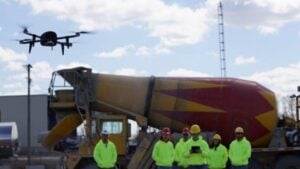 Woolpert, an engineering and geospatial services firm, has announced that it has been hired by Michigan Tech Research Institute (MTRI) to collect imagery via unmanned aerial system (UAS) of haul roads throughout the Midwest.
Woolpert, an engineering and geospatial services firm, has announced that it has been hired by Michigan Tech Research Institute (MTRI) to collect imagery via unmanned aerial system (UAS) of haul roads throughout the Midwest.
This project, “Characterization of Unpaved Road Conditions Through the Use of Remote Sensing,” is sponsored by the U.S. Department of Transportation (USDOT), Office of the Assistant Secretary for Research and Technology (OST-R).
The data collected will help test a set of algorithms developed by MTRI, a branch of Michigan Technological University located in central Michigan.
“The contract is to help commercialize computerized analysis and assessment of unpaved roads,” said Aaron Lawrence, Woolpert GIS expert and UAS technology developer. “Michigan Tech has some algorithms to detect potholes, rutting, damage, etc., through high-resolution imagery and 3D point clouds, which would be used to assess and address unstable roads.”
The UAS is intended to provide a fast, safe and cost-effective collection to better understand where road material is lost and what damage there is to these roads.
“If I’ve got a 25-ton truck on a dirt road, and the road bank is unstable, that would be a safety hazard,” Lawrence said. “The key is identifying these issues before something bad happens.”
Woolpert has been employing UAS for multiple industries that require efficient, remote and highly accurate imagery collections.
In addition to roads projects, the national architecture, engineering and geospatial firm is tasking UAS for oil and gas surveying, site design and civil engineering.
“UAS is ideally suited to smaller, rural sites,” Lawrence said. “It’s safer and it’s more cost-effective than flying individual manned aircraft missions, and in many cases we can turn around the imagery in 24 hours or less.”
Lawrence added that gathering imagery and generating 3D models of construction sites and the unpaved roads that provide access to them helps companies monitor construction, inventory material or simulate runoff scenarios to ensure designated retention ponds are collecting material as designed, instead of the surrounding rivers and streams.
“Post-construction UAS imagery can be very useful because it captures significant change to the area after companies clear and level land, install equipment or build haul roads,” Lawrence said.


















